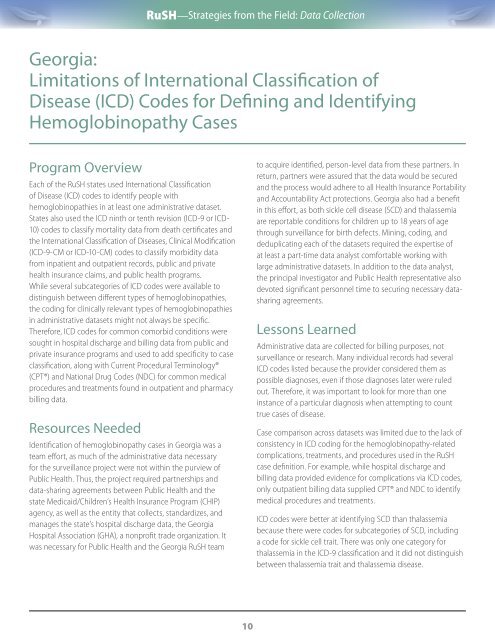RuSH: Strategies from the Field - Centers for Disease Control and ...
RuSH: Strategies from the Field - Centers for Disease Control and ...
RuSH: Strategies from the Field - Centers for Disease Control and ...
You also want an ePaper? Increase the reach of your titles
YUMPU automatically turns print PDFs into web optimized ePapers that Google loves.
<strong>RuSH</strong>—<strong>Strategies</strong> <strong>from</strong> <strong>the</strong> <strong>Field</strong>: Data Collection<br />
Georgia:<br />
Limitations of International Classification of<br />
<strong>Disease</strong> (ICD) Codes <strong>for</strong> Defining <strong>and</strong> Identifying<br />
Hemoglobinopathy Cases<br />
Program Overview<br />
Each of <strong>the</strong> <strong>RuSH</strong> states used International Classification<br />
of <strong>Disease</strong> (ICD) codes to identify people with<br />
hemoglobinopathies in at least one administrative dataset.<br />
States also used <strong>the</strong> ICD ninth or tenth revision (ICD-9 or ICD-<br />
10) codes to classify mortality data <strong>from</strong> death certificates <strong>and</strong><br />
<strong>the</strong> International Classification of <strong>Disease</strong>s, Clinical Modification<br />
(ICD-9-CM or ICD-10-CM) codes to classify morbidity data<br />
<strong>from</strong> inpatient <strong>and</strong> outpatient records, public <strong>and</strong> private<br />
health insurance claims, <strong>and</strong> public health programs.<br />
While several subcategories of ICD codes were available to<br />
distinguish between different types of hemoglobinopathies,<br />
<strong>the</strong> coding <strong>for</strong> clinically relevant types of hemoglobinopathies<br />
in administrative datasets might not always be specific.<br />
There<strong>for</strong>e, ICD codes <strong>for</strong> common comorbid conditions were<br />
sought in hospital discharge <strong>and</strong> billing data <strong>from</strong> public <strong>and</strong><br />
private insurance programs <strong>and</strong> used to add specificity to case<br />
classification, along with Current Procedural Terminology®<br />
(CPT®) <strong>and</strong> National Drug Codes (NDC) <strong>for</strong> common medical<br />
procedures <strong>and</strong> treatments found in outpatient <strong>and</strong> pharmacy<br />
billing data.<br />
Resources Needed<br />
Identification of hemoglobinopathy cases in Georgia was a<br />
team ef<strong>for</strong>t, as much of <strong>the</strong> administrative data necessary<br />
<strong>for</strong> <strong>the</strong> surveillance project were not within <strong>the</strong> purview of<br />
Public Health. Thus, <strong>the</strong> project required partnerships <strong>and</strong><br />
data-sharing agreements between Public Health <strong>and</strong> <strong>the</strong><br />
state Medicaid/Children’s Health Insurance Program (CHIP)<br />
agency, as well as <strong>the</strong> entity that collects, st<strong>and</strong>ardizes, <strong>and</strong><br />
manages <strong>the</strong> state’s hospital discharge data, <strong>the</strong> Georgia<br />
Hospital Association (GHA), a nonprofit trade organization. It<br />
was necessary <strong>for</strong> Public Health <strong>and</strong> <strong>the</strong> Georgia <strong>RuSH</strong> team<br />
10<br />
to acquire identified, person-level data <strong>from</strong> <strong>the</strong>se partners. In<br />
return, partners were assured that <strong>the</strong> data would be secured<br />
<strong>and</strong> <strong>the</strong> process would adhere to all Health Insurance Portability<br />
<strong>and</strong> Accountability Act protections. Georgia also had a benefit<br />
in this ef<strong>for</strong>t, as both sickle cell disease (SCD) <strong>and</strong> thalassemia<br />
are reportable conditions <strong>for</strong> children up to 18 years of age<br />
through surveillance <strong>for</strong> birth defects. Mining, coding, <strong>and</strong><br />
deduplicating each of <strong>the</strong> datasets required <strong>the</strong> expertise of<br />
at least a part-time data analyst com<strong>for</strong>table working with<br />
large administrative datasets. In addition to <strong>the</strong> data analyst,<br />
<strong>the</strong> principal investigator <strong>and</strong> Public Health representative also<br />
devoted significant personnel time to securing necessary datasharing<br />
agreements.<br />
Lessons Learned<br />
Administrative data are collected <strong>for</strong> billing purposes, not<br />
surveillance or research. Many individual records had several<br />
ICD codes listed because <strong>the</strong> provider considered <strong>the</strong>m as<br />
possible diagnoses, even if those diagnoses later were ruled<br />
out. There<strong>for</strong>e, it was important to look <strong>for</strong> more than one<br />
instance of a particular diagnosis when attempting to count<br />
true cases of disease.<br />
Case comparison across datasets was limited due to <strong>the</strong> lack of<br />
consistency in ICD coding <strong>for</strong> <strong>the</strong> hemoglobinopathy-related<br />
complications, treatments, <strong>and</strong> procedures used in <strong>the</strong> <strong>RuSH</strong><br />
case definition. For example, while hospital discharge <strong>and</strong><br />
billing data provided evidence <strong>for</strong> complications via ICD codes,<br />
only outpatient billing data supplied CPT® <strong>and</strong> NDC to identify<br />
medical procedures <strong>and</strong> treatments.<br />
ICD codes were better at identifying SCD than thalassemia<br />
because <strong>the</strong>re were codes <strong>for</strong> subcategories of SCD, including<br />
a code <strong>for</strong> sickle cell trait. There was only one category <strong>for</strong><br />
thalassemia in <strong>the</strong> ICD-9 classification <strong>and</strong> it did not distinguish<br />
between thalassemia trait <strong>and</strong> thalassemia disease.

















